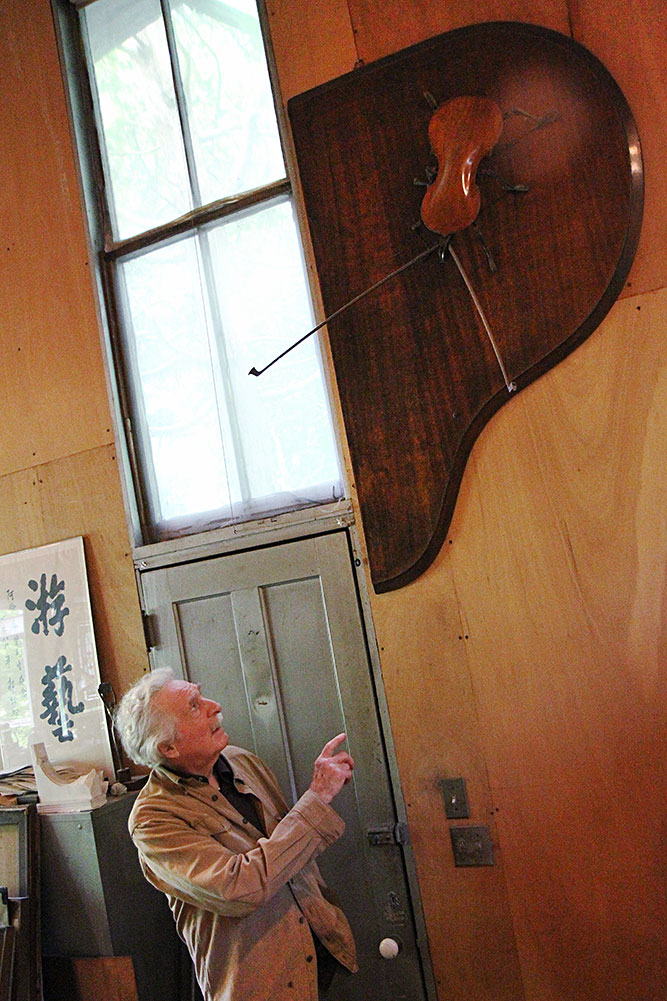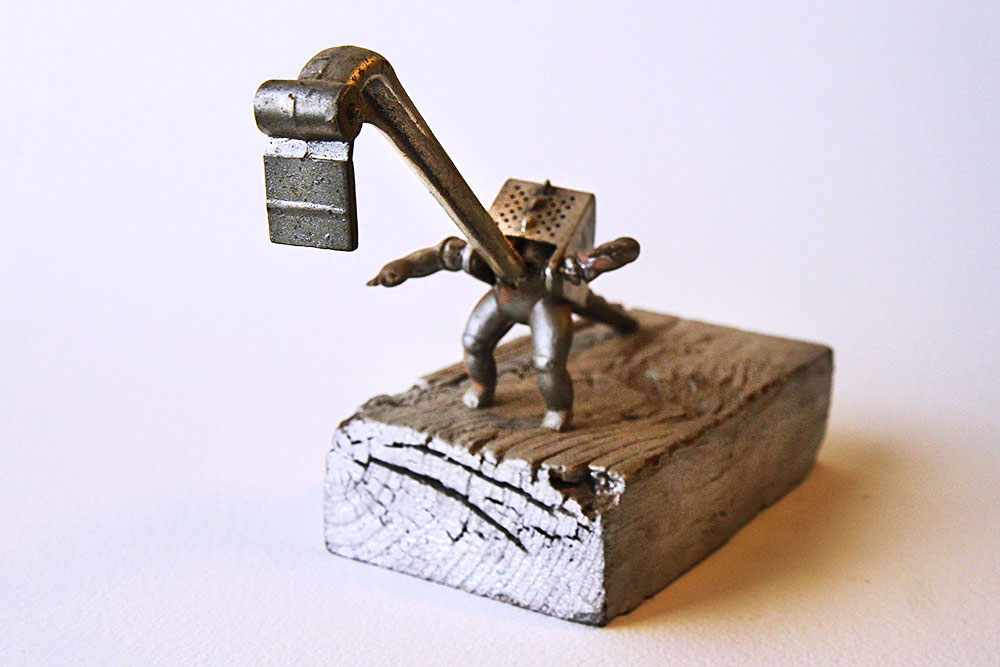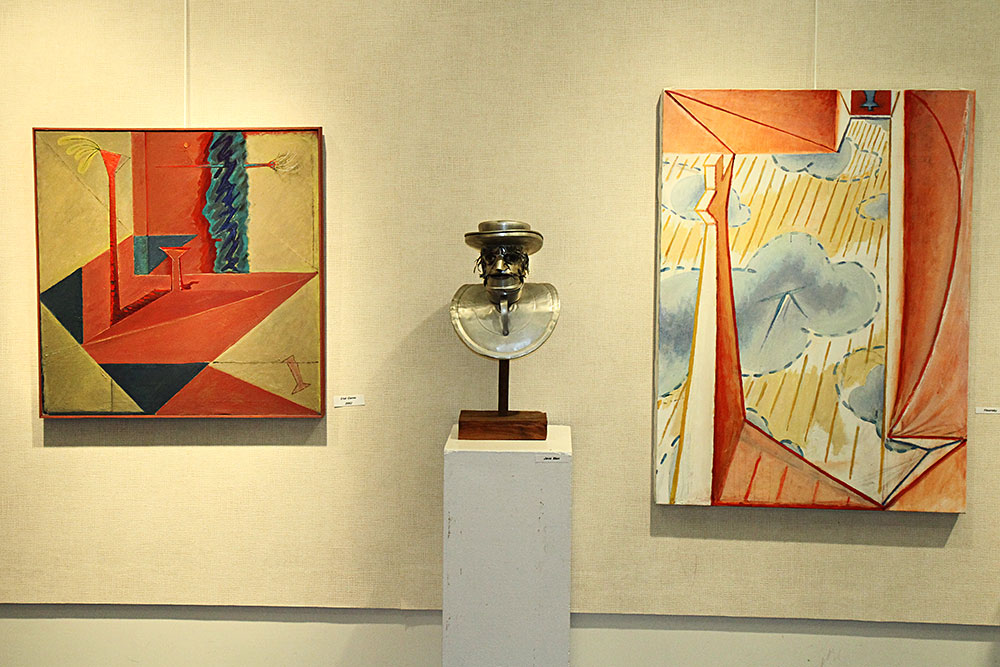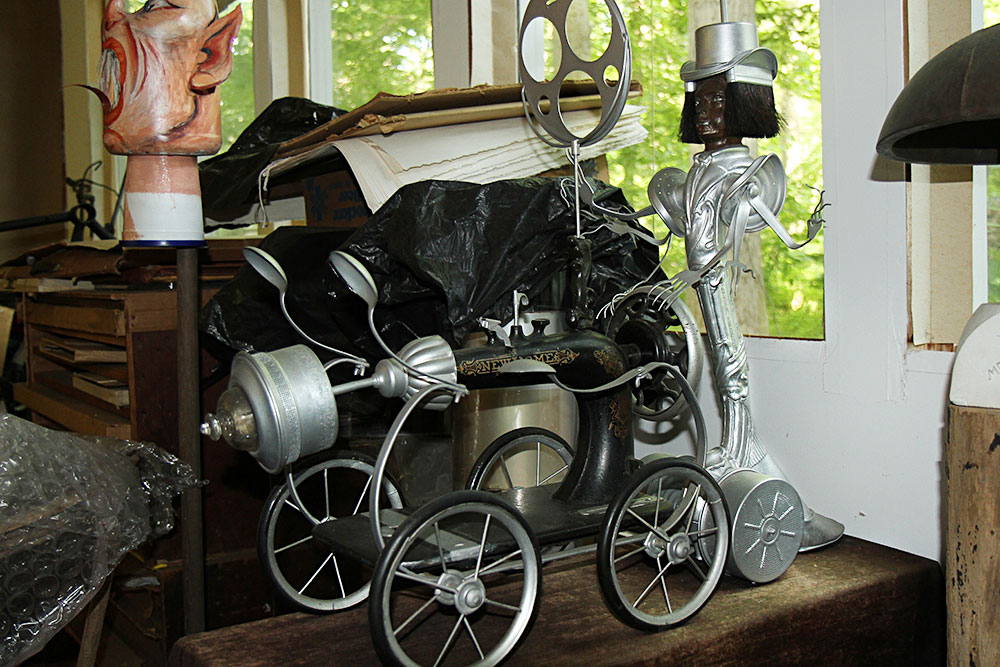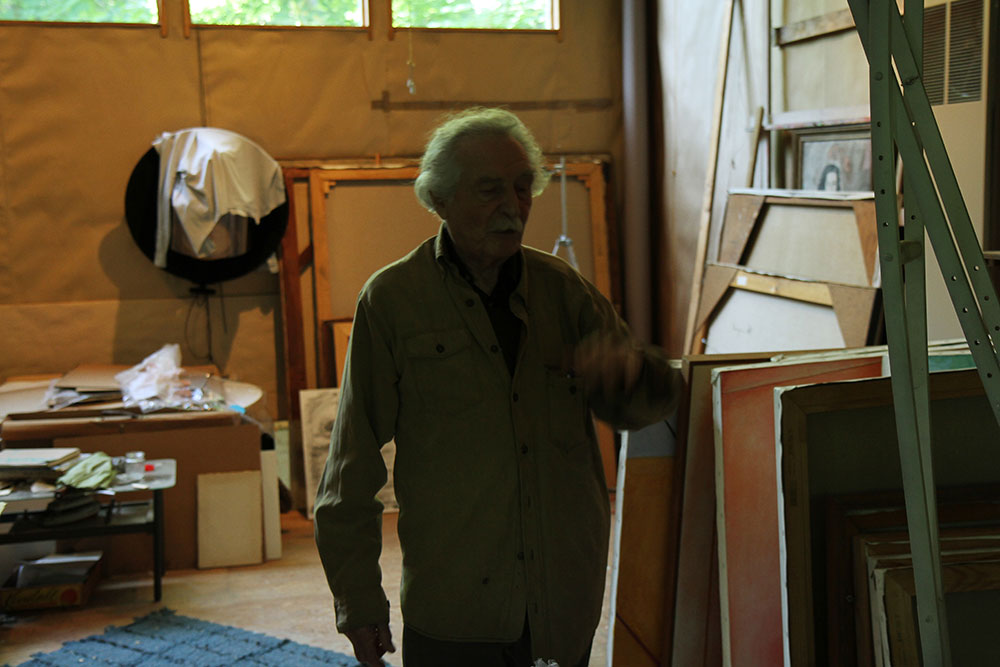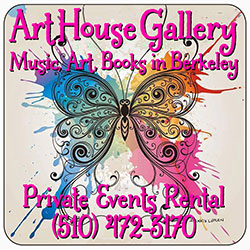Aaron Kurzen: Art Master, Nice Guy, Wild Surrealist
by Doniphan Blair
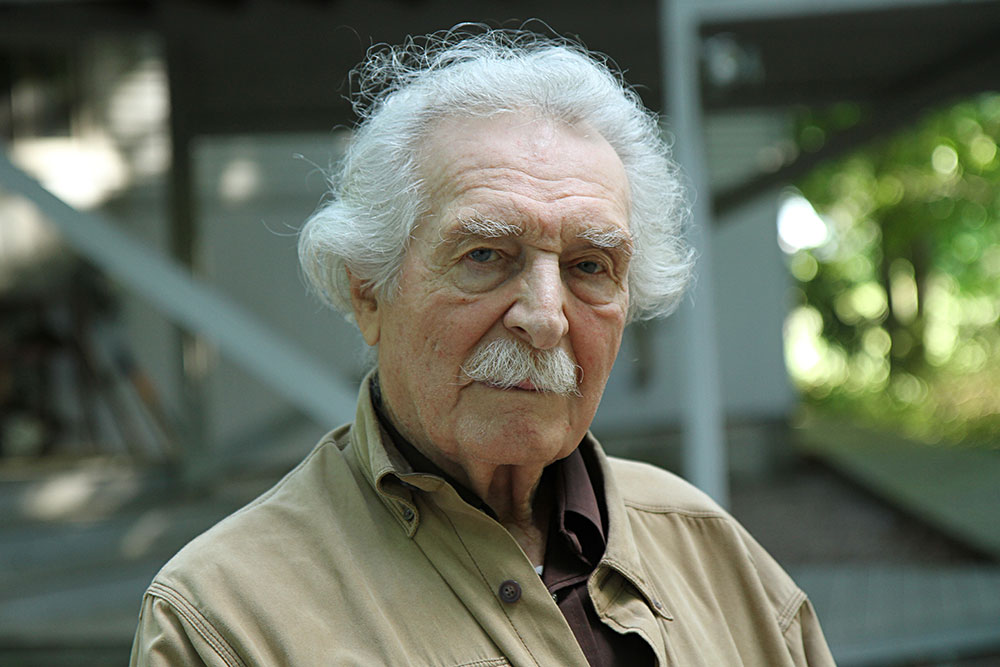 Painter, sculptor, teacher and philosopher Aaron Kurzen, at his home in Stony Brook, Connecticut. photo: D. BlairPLEASE support our GoFundMe campaign to cover research expenses for our articles and rebuilding the cineSOURCE site.
Painter, sculptor, teacher and philosopher Aaron Kurzen, at his home in Stony Brook, Connecticut. photo: D. BlairPLEASE support our GoFundMe campaign to cover research expenses for our articles and rebuilding the cineSOURCE site.
“YOU WERE LIKE A SHAMAN TO ME,"
I told the old man with a bushy white mustache and matching hair, shortly after we met outside the mayor’s office of the small Connecticut town near where he lived.
“A shaman?" he asked, incredulous, with a slight smile. "How could that be?”
“You were like Don Juan, the shaman from the Carlos Castaneda books I was reading at the time. You were mysterious. You didn’t reveal your opinions, and you forced me to imagine what they were.”
“That’s ridiculous,” he responded, without rancor. “I was hardly a shaman, and I told you exactly how I felt. I was always honest with you.”
Indeed, I could recall him telling me, almost 50 years earlier, that I should put something really strange in one of my paintings. He suggested a semaphore—the signal alongside railroad tracks, he had to explain—and I obliged.
What 16-year-old doesn’t love surrealism and its dream fluency? Or a teacher who is calm and friendly as well as knowledgeable and dedicated, even if enigmatic. Alas, it took me years to realize: He was the perfect guide for someone like me, desperately trying to embark on the odyssey of art.
Little did I know, Aaron Kurzen (1921-2022) was an actual surrealist. He didn’t tell us, naturally, the other teachers honored that discretion, and he never showed anything around the school but, in point of fact, he was the primary disciple of Marcel Duchamp (1887-1968). A Parisian avant-gardist who moved to New York, Duchamp became the main precursor of surrealism when he stopped painting to make “ready-mades”, like the unmodified urinal and bottle rack he proclaimed as art. Aaron met Duchamp while still in his teens, it seems, introduced by the gorgeous, ethereal, almost albino blond, young woman he met immediately after moving from Minnesota to New York.
Lenore Dunn, AKA Saja, was already an actress and Vogue model but her day job was assisting an art collector, Walter Arensburg, who was a fan of Duchamp. Aaron and Saja married and proceeded to transmit those ideas as well as their romanticism to some of New York’s burgeoning crop of painters, like their friend Robert Rauschenberg.
Aaron pushed Duchamp’s idea-oriented aesthetics toward the sensual with his whimsical sculptures, which were assemblages of ready-mades: a screaming Hitler, his teeth rows of browned-out cigar holders, an enormous cockroach, composed of a violin, “Garlic Presstasaurus" ("Reconstruction" series, 1977), a small beast made from a garlic press, which he gave me.
He also gave me a holographic piece, a two-foot tall, eight-inch wide structure, with a light and spinning plastic film. Ever the futurist, Aaron had started working with holograms as an art form in the 1980s. That brought him to San Francisco, where there was a studio specializing in holograms and I happened to live.
More than anything, however, Aaron was a painter.
“You never let us see your paintings,” I told him, after we went inside the municipal building and reviewed the retrospective of his work on display, with three or four dozen pieces. The paintings ranged through his often changing and mixing of styles, from classical draftsman to postmodern Matisse as well as surrealism, and were interspersed with his sculptures, although nothing that large or aggressive. I would see those later at his house outside town, which he built from a salvaged military Quonset hut.
“I didn’t see a single one of your paintings or sculptures until I graduated. Nor did anyone I knew,” I kept complaining, after we sat on a bench at the end of the show. “When I finally saw them, I assumed you did that on purpose. You didn’t want us to see how wild they were and become crazed Dadaists before we were ready.”
Indeed, when I finally visited his New York loft, I was overwhelmed by a massive surrealist-abstract piece, about 20 by eight feet, hanging from the ceiling over the living area. Although fuzzy in my memory, it was an impressive attack of wild colors, shapes and realistic details, including an explosion of sorts, perhaps emanating from a figure, which sent shrapnel scattering across the entire canvas.
“That’s ridiculous. I wasn’t hiding them,” Aaron said, gesturing at the show. “You could have come by any time. I lived only a mile from the school.” That would be Dalton, once a radical refuge for poetic girls, creative boys and the offspring of intellectuals, now one of Manhattan’s most elite and expensive private schools.
“You never invited me. And I wouldn’t have thought to ask you, the art master, standing guard over the art room... in your coat,” the white lab coat he always wore, buttoned up and with a tie underneath. “So, you weren’t trying to be inscrutable?”
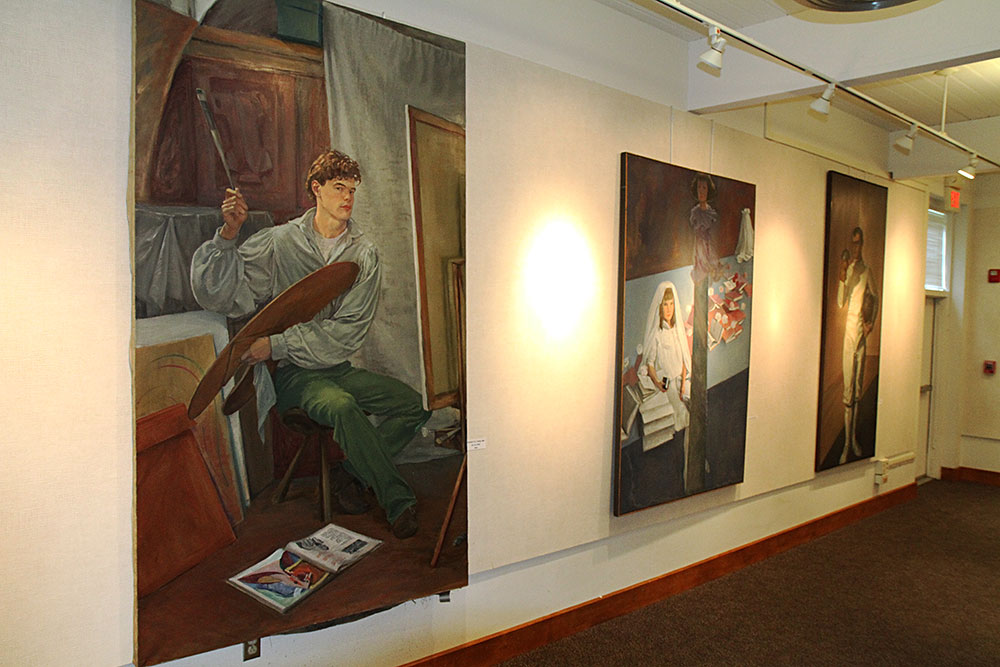 Kurzen's work ranged widely, the first on the left perhaps a self-portrait as a renaissance artist. photo: D. Blair“No, not at all,” he said, with a chuckle. “I was just observing, enjoying, taking it all in.”
Kurzen's work ranged widely, the first on the left perhaps a self-portrait as a renaissance artist. photo: D. Blair“No, not at all,” he said, with a chuckle. “I was just observing, enjoying, taking it all in.”
“I have always been relaxed about things. One time when I was three or so—this is a story my mother used to tell—she was wheeling me in a wagon down a street, in St Paul [Minnesota], where we lived.” His parents were European Jewish immigrants and his father was a tailor, hence an early interest in scissors and collage. “After a couple of blocks, she noticed I had fallen out of the wagon. She went back and there I was, sitting on the sidewalk, taking it all in.”
“You weren’t purposefully following a strategy, a way of teaching visionary art?” I continued, trying to find the answer to notions that had accumulated over the years—was he now doubling down by gaslighting me, I wondered.
“No, not at all,” Aaron repeated calmly, looking me in the eyes.
To be sure, Aaron had been my ally since before I knew he headed Dalton’s substantial art department.
He admitted me to the life drawing class, although I was only in the eighth grade. Gazing on nude models and translating their images into lines was oddly therapeutic for my extreme horniness, inflamed by poetic girls. Ever vigilant to the equilibrium between vision and precision, Aaron would interrupt my reverie by dangling a yard stick in front of my drawing, to show how the model’s chin was above her knee, say, while in reality it was above her ankle—as he would prove by dangling it in front of the model.
After about a year hanging around the art room constantly and finally doing some serious paintings, Aaron invited me to join a private seminar on renaissance art, just me and my friend Nick Fain.
Already a mature cartoonist, Nick was known for "performative drawing." While we art roomers watched, he would render an oversized cartoon of the headmaster masturbating, for example, albeit only when Aaron wasn’t around, although he must have heard tell. Given his delicate dance between upstanding and avant, Aaron wouldn’t have risked his sinecure tolerating such disrespect of the school’s director, known to be a disciplinarian, a certain Donald Barr, father of the future attorney general, William.
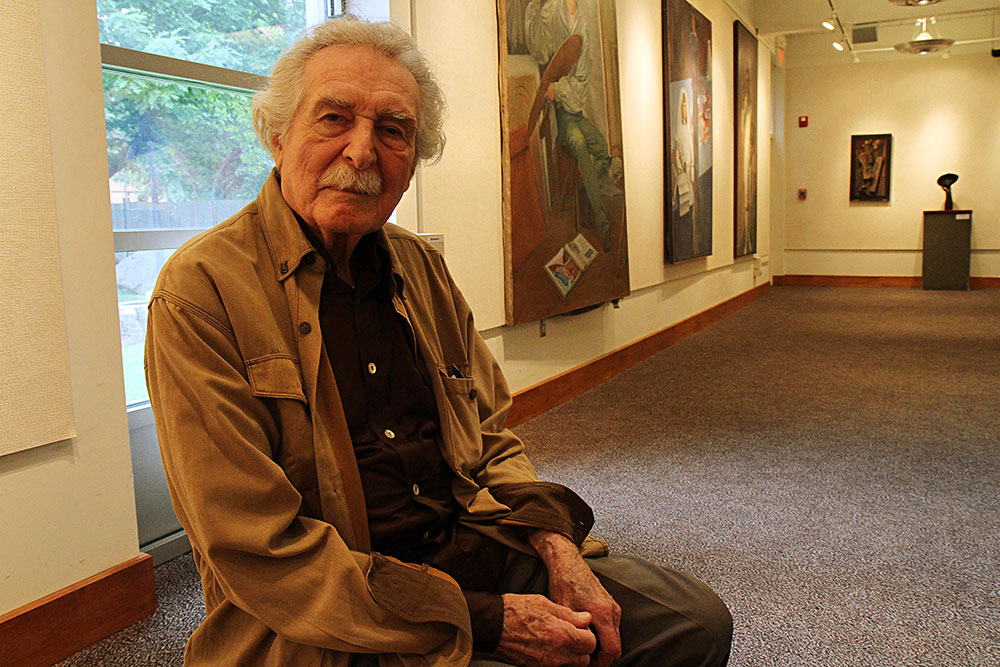 We lingered for a long time at Kurzen's show, which may have been bittersweet, affirming his life work but confirming rejection by New York critics. photo: D. BlairAaron, Nick and I met only a half-dozen times—sitting on a bench to the side of the art room, pouring over the amply-illustrated, oversized, scholarly book Aaron would extract from his art closet—but that was enough study material for a semester, if not a lifetime. We learned about theories of proportion and composition, including the Golden Mean and “rabotna,” a term I have yet to see elsewhere (it means using the short side of a painting to divide the long side compositionly).
We lingered for a long time at Kurzen's show, which may have been bittersweet, affirming his life work but confirming rejection by New York critics. photo: D. BlairAaron, Nick and I met only a half-dozen times—sitting on a bench to the side of the art room, pouring over the amply-illustrated, oversized, scholarly book Aaron would extract from his art closet—but that was enough study material for a semester, if not a lifetime. We learned about theories of proportion and composition, including the Golden Mean and “rabotna,” a term I have yet to see elsewhere (it means using the short side of a painting to divide the long side compositionly).
Those of us entranced by the odyssey of art spent long hours in the art room, working silently at easels or on canvases affixed to the wall or sitting around the central table, abiding Aaron’s assignments or enjoying his occasional comment, a process amplified by Dalton’s theory of education. Developed by Helen Parkhurst around 1919, the “lab plan" involved giving students monthly assignments and a free hour or two a day, the laboratory, to work individually or with a teacher. Along with the Matathias System, teacher-monitored student diaries, which is psychoanalytic as well as shamanistic, the Lab Plan is one of the most impressive pedagogical tools I have ever seen and worth universal adoption.
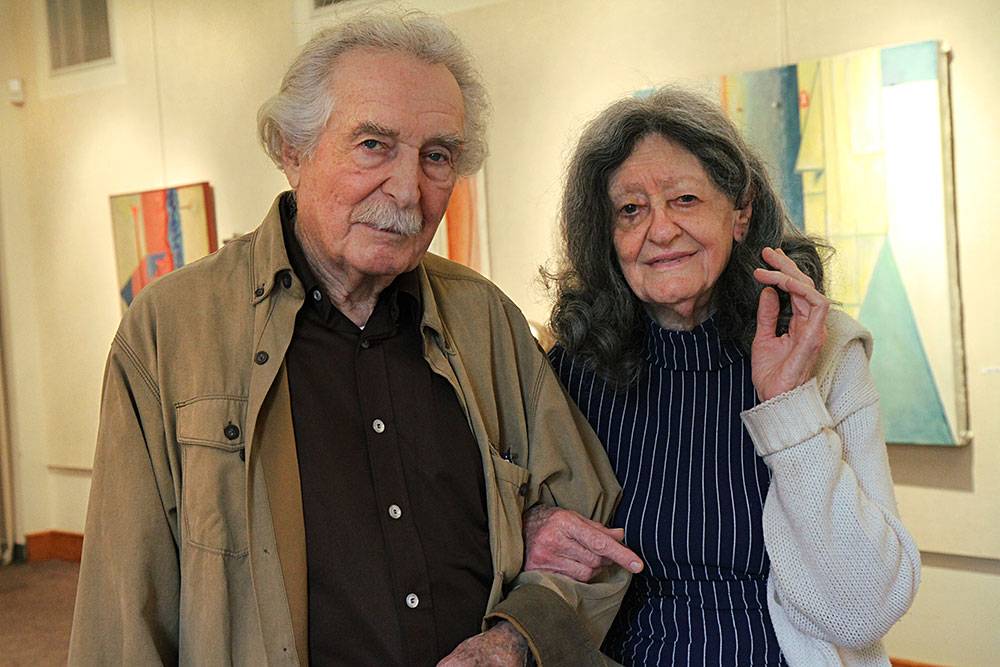 Kurzen and his 'baby' sister, Estelle, who lived nearby and with whom he took many of his meals. photo: D. BlairAaron’s mysterious method and encyclopedic knowledge were perfect for the Lab Plan, in fact, and he came to have immense influence on hundreds if not thousands of students, many of whom became artists.
Kurzen and his 'baby' sister, Estelle, who lived nearby and with whom he took many of his meals. photo: D. BlairAaron’s mysterious method and encyclopedic knowledge were perfect for the Lab Plan, in fact, and he came to have immense influence on hundreds if not thousands of students, many of whom became artists.
After reviewing his retrospective, which really should have been in a New York City gallery or museum, not a country town's municipal office, we turned to mutual friends, mostly from Dalton, whom Aaron remembered with astounding detail. That amazed me, given he was 93 and his short-term memory was shot. During our phone conversation to arrange my visit, he had asked me about five times if I was coming and when. Regardless, he was completely cogent when it came to long-term memory and walked almost briskly, without a cane.
We went to lunch with his three-years-younger sister, Estelle, who had been relaxing in the back of the gallery, driving them in my car to her assisted living facility, where they often took their meals. “I like to eat with my little sister,” he said, smiling at her. “He doesn’t like to cook,” she teased.
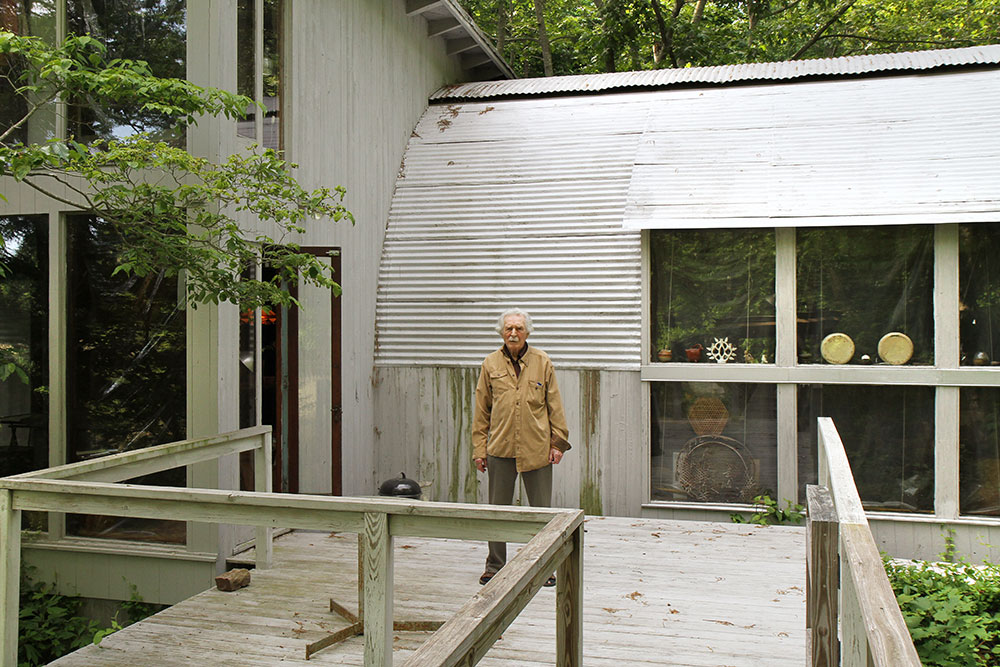 Kurzen in front of his Quonset hut house, replete with many additions, including a studio out back and pier into his backyard marsh. photo: D. BlairThen we went back to his Quonset hut house, which looked out on a flourishing marsh full of reeds, into which he had built a substantial pier. "You can see a lot of wild life," he said, when we walked out on it. The carpenter who built it showed up, coincidentally, a working-class hippie with whom Aaron had a jovial repartee.
Kurzen in front of his Quonset hut house, replete with many additions, including a studio out back and pier into his backyard marsh. photo: D. BlairThen we went back to his Quonset hut house, which looked out on a flourishing marsh full of reeds, into which he had built a substantial pier. "You can see a lot of wild life," he said, when we walked out on it. The carpenter who built it showed up, coincidentally, a working-class hippie with whom Aaron had a jovial repartee.
In back of the house was his studio, all of which he called Zen Acre, in keeping with his last name but also philosophy. Both the house and studio were filled with incredible art, some by famous friends, and many sculptures, often larger and more aggressive than in the show, like the almost life-size woman wheeling a baby in a carriage, all fashioned from cooking implements.
We talked nonstop. He inquired of my life and work, listened attentively, and looked intently at some phone images and the one large watercolor I brought. He talked about his life and work, notably in the ‘50s.
“I did not have that monomaniacal drive to succeed, like Bob,” Aaron said, referring to his friend Robert Rauschenberg. “And I wasn’t in his gay mafia,” he added, without rancor, providing a glimpse into the little-recognized queer power of olden days, particularly in male-only cohorts.
There must have been more to why he wasn't embraced by the New York critics, given his discipleship with Duchamp and immense oeuvre of satirical sculptures and imaginative paintings—not to mention romantic imprimatur by Saja, a poetic alpha female. Alas, our few hours together on that muggy summer day in 2014 didn't provide an opening for that exploration, especially after my exhaustive shamanism examination.
Apparently, Aaron was consummately heterosexual as well as evolved, able to balance the artist's self-focus with cohabiting with a powerful woman. I met Saja only once and for only a second, but she was obviously amazing. Her passing, comparatively young in 1999, must have been heart breaking for Aaron, probably made more acute by the fact they were childless. Eventually, Aaron connected with Beatrice Perry, the sculptor, art dealer and heiress, and lived with her in a mansion overlooking the Hudson River until her death in 2011.
As I learned about Aaron’s relationships, I could not help but think that his sophisticated male-female understanding was yet another side of the shamanism he so stridently denied, making him ever the excellent guide in the art warrior’s way.
Posted on Mar 30, 2023 - 10:59 PM
by Doniphan Blair
 Painter, sculptor, teacher and philosopher Aaron Kurzen, at his home in Stony Brook, Connecticut. photo: D. Blair
Painter, sculptor, teacher and philosopher Aaron Kurzen, at his home in Stony Brook, Connecticut. photo: D. Blair“YOU WERE LIKE A SHAMAN TO ME,"
I told the old man with a bushy white mustache and matching hair, shortly after we met outside the mayor’s office of the small Connecticut town near where he lived.
“A shaman?" he asked, incredulous, with a slight smile. "How could that be?”
“You were like Don Juan, the shaman from the Carlos Castaneda books I was reading at the time. You were mysterious. You didn’t reveal your opinions, and you forced me to imagine what they were.”
“That’s ridiculous,” he responded, without rancor. “I was hardly a shaman, and I told you exactly how I felt. I was always honest with you.”
Indeed, I could recall him telling me, almost 50 years earlier, that I should put something really strange in one of my paintings. He suggested a semaphore—the signal alongside railroad tracks, he had to explain—and I obliged.
What 16-year-old doesn’t love surrealism and its dream fluency? Or a teacher who is calm and friendly as well as knowledgeable and dedicated, even if enigmatic. Alas, it took me years to realize: He was the perfect guide for someone like me, desperately trying to embark on the odyssey of art.
Little did I know, Aaron Kurzen (1921-2022) was an actual surrealist. He didn’t tell us, naturally, the other teachers honored that discretion, and he never showed anything around the school but, in point of fact, he was the primary disciple of Marcel Duchamp (1887-1968). A Parisian avant-gardist who moved to New York, Duchamp became the main precursor of surrealism when he stopped painting to make “ready-mades”, like the unmodified urinal and bottle rack he proclaimed as art. Aaron met Duchamp while still in his teens, it seems, introduced by the gorgeous, ethereal, almost albino blond, young woman he met immediately after moving from Minnesota to New York.
Lenore Dunn, AKA Saja, was already an actress and Vogue model but her day job was assisting an art collector, Walter Arensburg, who was a fan of Duchamp. Aaron and Saja married and proceeded to transmit those ideas as well as their romanticism to some of New York’s burgeoning crop of painters, like their friend Robert Rauschenberg.
Aaron pushed Duchamp’s idea-oriented aesthetics toward the sensual with his whimsical sculptures, which were assemblages of ready-mades: a screaming Hitler, his teeth rows of browned-out cigar holders, an enormous cockroach, composed of a violin, “Garlic Presstasaurus" ("Reconstruction" series, 1977), a small beast made from a garlic press, which he gave me.
He also gave me a holographic piece, a two-foot tall, eight-inch wide structure, with a light and spinning plastic film. Ever the futurist, Aaron had started working with holograms as an art form in the 1980s. That brought him to San Francisco, where there was a studio specializing in holograms and I happened to live.
More than anything, however, Aaron was a painter.
“You never let us see your paintings,” I told him, after we went inside the municipal building and reviewed the retrospective of his work on display, with three or four dozen pieces. The paintings ranged through his often changing and mixing of styles, from classical draftsman to postmodern Matisse as well as surrealism, and were interspersed with his sculptures, although nothing that large or aggressive. I would see those later at his house outside town, which he built from a salvaged military Quonset hut.
“I didn’t see a single one of your paintings or sculptures until I graduated. Nor did anyone I knew,” I kept complaining, after we sat on a bench at the end of the show. “When I finally saw them, I assumed you did that on purpose. You didn’t want us to see how wild they were and become crazed Dadaists before we were ready.”
Indeed, when I finally visited his New York loft, I was overwhelmed by a massive surrealist-abstract piece, about 20 by eight feet, hanging from the ceiling over the living area. Although fuzzy in my memory, it was an impressive attack of wild colors, shapes and realistic details, including an explosion of sorts, perhaps emanating from a figure, which sent shrapnel scattering across the entire canvas.
“That’s ridiculous. I wasn’t hiding them,” Aaron said, gesturing at the show. “You could have come by any time. I lived only a mile from the school.” That would be Dalton, once a radical refuge for poetic girls, creative boys and the offspring of intellectuals, now one of Manhattan’s most elite and expensive private schools.
“You never invited me. And I wouldn’t have thought to ask you, the art master, standing guard over the art room... in your coat,” the white lab coat he always wore, buttoned up and with a tie underneath. “So, you weren’t trying to be inscrutable?”
 Kurzen's work ranged widely, the first on the left perhaps a self-portrait as a renaissance artist. photo: D. Blair
Kurzen's work ranged widely, the first on the left perhaps a self-portrait as a renaissance artist. photo: D. Blair“I have always been relaxed about things. One time when I was three or so—this is a story my mother used to tell—she was wheeling me in a wagon down a street, in St Paul [Minnesota], where we lived.” His parents were European Jewish immigrants and his father was a tailor, hence an early interest in scissors and collage. “After a couple of blocks, she noticed I had fallen out of the wagon. She went back and there I was, sitting on the sidewalk, taking it all in.”
“You weren’t purposefully following a strategy, a way of teaching visionary art?” I continued, trying to find the answer to notions that had accumulated over the years—was he now doubling down by gaslighting me, I wondered.
“No, not at all,” Aaron repeated calmly, looking me in the eyes.
To be sure, Aaron had been my ally since before I knew he headed Dalton’s substantial art department.
He admitted me to the life drawing class, although I was only in the eighth grade. Gazing on nude models and translating their images into lines was oddly therapeutic for my extreme horniness, inflamed by poetic girls. Ever vigilant to the equilibrium between vision and precision, Aaron would interrupt my reverie by dangling a yard stick in front of my drawing, to show how the model’s chin was above her knee, say, while in reality it was above her ankle—as he would prove by dangling it in front of the model.
After about a year hanging around the art room constantly and finally doing some serious paintings, Aaron invited me to join a private seminar on renaissance art, just me and my friend Nick Fain.
Already a mature cartoonist, Nick was known for "performative drawing." While we art roomers watched, he would render an oversized cartoon of the headmaster masturbating, for example, albeit only when Aaron wasn’t around, although he must have heard tell. Given his delicate dance between upstanding and avant, Aaron wouldn’t have risked his sinecure tolerating such disrespect of the school’s director, known to be a disciplinarian, a certain Donald Barr, father of the future attorney general, William.
 We lingered for a long time at Kurzen's show, which may have been bittersweet, affirming his life work but confirming rejection by New York critics. photo: D. Blair
We lingered for a long time at Kurzen's show, which may have been bittersweet, affirming his life work but confirming rejection by New York critics. photo: D. BlairThose of us entranced by the odyssey of art spent long hours in the art room, working silently at easels or on canvases affixed to the wall or sitting around the central table, abiding Aaron’s assignments or enjoying his occasional comment, a process amplified by Dalton’s theory of education. Developed by Helen Parkhurst around 1919, the “lab plan" involved giving students monthly assignments and a free hour or two a day, the laboratory, to work individually or with a teacher. Along with the Matathias System, teacher-monitored student diaries, which is psychoanalytic as well as shamanistic, the Lab Plan is one of the most impressive pedagogical tools I have ever seen and worth universal adoption.
 Kurzen and his 'baby' sister, Estelle, who lived nearby and with whom he took many of his meals. photo: D. Blair
Kurzen and his 'baby' sister, Estelle, who lived nearby and with whom he took many of his meals. photo: D. BlairAfter reviewing his retrospective, which really should have been in a New York City gallery or museum, not a country town's municipal office, we turned to mutual friends, mostly from Dalton, whom Aaron remembered with astounding detail. That amazed me, given he was 93 and his short-term memory was shot. During our phone conversation to arrange my visit, he had asked me about five times if I was coming and when. Regardless, he was completely cogent when it came to long-term memory and walked almost briskly, without a cane.
We went to lunch with his three-years-younger sister, Estelle, who had been relaxing in the back of the gallery, driving them in my car to her assisted living facility, where they often took their meals. “I like to eat with my little sister,” he said, smiling at her. “He doesn’t like to cook,” she teased.
 Kurzen in front of his Quonset hut house, replete with many additions, including a studio out back and pier into his backyard marsh. photo: D. Blair
Kurzen in front of his Quonset hut house, replete with many additions, including a studio out back and pier into his backyard marsh. photo: D. BlairIn back of the house was his studio, all of which he called Zen Acre, in keeping with his last name but also philosophy. Both the house and studio were filled with incredible art, some by famous friends, and many sculptures, often larger and more aggressive than in the show, like the almost life-size woman wheeling a baby in a carriage, all fashioned from cooking implements.
We talked nonstop. He inquired of my life and work, listened attentively, and looked intently at some phone images and the one large watercolor I brought. He talked about his life and work, notably in the ‘50s.
“I did not have that monomaniacal drive to succeed, like Bob,” Aaron said, referring to his friend Robert Rauschenberg. “And I wasn’t in his gay mafia,” he added, without rancor, providing a glimpse into the little-recognized queer power of olden days, particularly in male-only cohorts.
There must have been more to why he wasn't embraced by the New York critics, given his discipleship with Duchamp and immense oeuvre of satirical sculptures and imaginative paintings—not to mention romantic imprimatur by Saja, a poetic alpha female. Alas, our few hours together on that muggy summer day in 2014 didn't provide an opening for that exploration, especially after my exhaustive shamanism examination.
Apparently, Aaron was consummately heterosexual as well as evolved, able to balance the artist's self-focus with cohabiting with a powerful woman. I met Saja only once and for only a second, but she was obviously amazing. Her passing, comparatively young in 1999, must have been heart breaking for Aaron, probably made more acute by the fact they were childless. Eventually, Aaron connected with Beatrice Perry, the sculptor, art dealer and heiress, and lived with her in a mansion overlooking the Hudson River until her death in 2011.
As I learned about Aaron’s relationships, I could not help but think that his sophisticated male-female understanding was yet another side of the shamanism he so stridently denied, making him ever the excellent guide in the art warrior’s way.
Posted on Mar 30, 2023 - 10:59 PM















